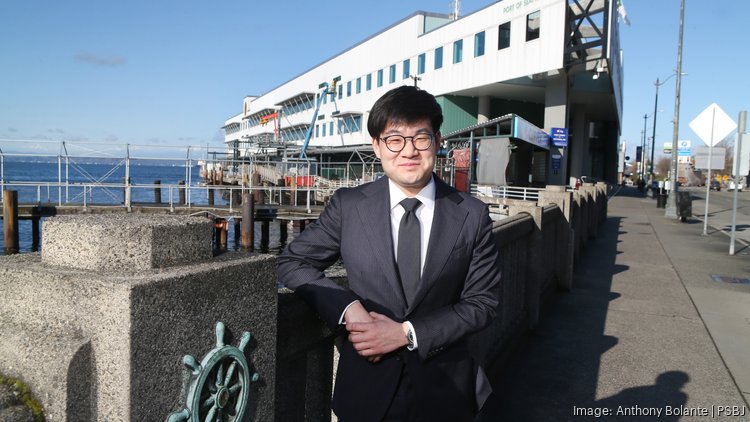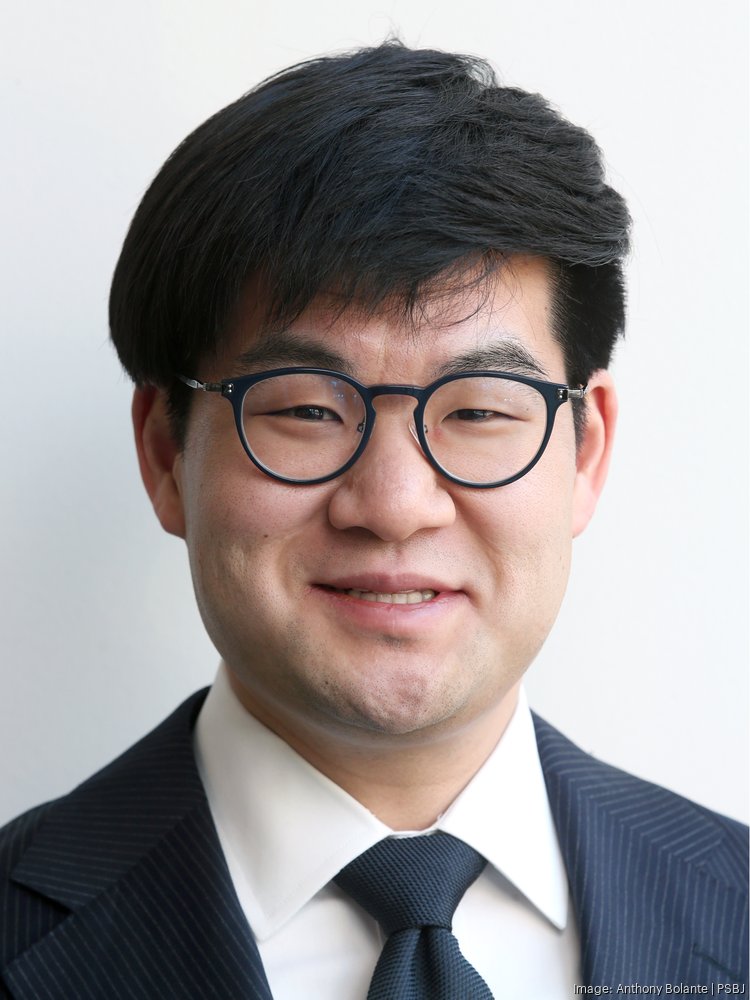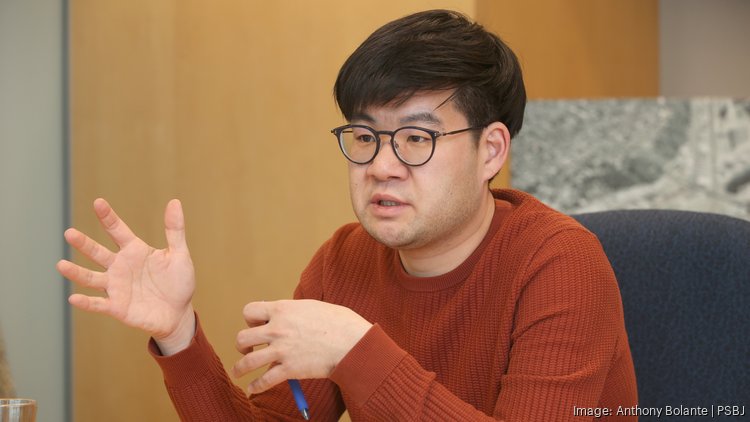
The 32-year-old sat down with the Business Journal to talk about the technological and market opportunities for the port and how it is preparing for a potential economic downturn.

Port of Seattle Commission President Sam Cho
About Sam:
Job: Port of Seattle Commission President
Board positions: Bellevue Chamber of Commerce, Greater Seattle Partners Board of Directors, Washington Council on International Trade, Washington State China Relations Council Board, Washington State China Relations Council Executive Board
Education: Bachelor’s degree from American University, master’s degree from the London School of Economics
Work experience:
- Legislative Assistant, U.S. House of Representatives
- Special Assistant, U.S. General Services Administration
- Legislative Assistant, Washington State Senate
- Founder & CEO, Seven Seas Export
- Manager of Public Policy for Loftium, Lyft
- Advisor and investor for Fanded, Coding Dojo, YouthBio Therapeutics, AeonCharge
- General Manager of U.S. Northwest, Volta Charging
- Port of Seattle Commissioner since Dec. 2019
Cho, speaking at Port headquarters at Pier 69 in Seattle, says one of the more controversial aspects of the supply chain right now is automation.
DAY IN THE LIFE: Sam breaks down a typical day outside of work:
Morning
- I start my day with an Athletic Greens health nutrition shake, then coffee. I’m not a huge breakfast person.
- I spend 30 to 45 minutes reading the news.
- When I’m in the car by myself, my preferred soundtrack is an audiobook or a good podcast.
Evening
- On days I don’t get to the gym, I work out with a heavy bag in the basement for cardio and stress relief.
- I turn off all electronic devices an hour before bed. Sometimes, I play “rain sounds” on my Alexa; maybe it’s because I grew up in Seattle, but the sound of rain helps me fall asleep.
What are some of your top priorities in your first few months as commission president?
My parents immigrated to Seattle through Seattle-Tacoma International Airport, and for their son to become the president of the Port Commission is a pretty cool, full-circle moment for us. A lot of my family’s experience as immigrants and growing up here in the Seattle area shapes the policies and the things I want to push at the Port. We’re the gateway to the Pacific Northwest but also to the Midwest. So I really want to focus on re-engaging with the world post-pandemic.
How fares the supply chain recovery?
Given the supply chain issues that we had during the pandemic, the congestion, we really showed that Seattle and the (Northwest) Seaport Alliance is an area of relief for the Long Beaches and the LA’s of the world. For this year, part of the challenge and goal would be to retain the market share that we captured during the pandemic and build upon it in a way where we’re growing the number of containers going through our port. We were the only port on the West Coast that added terminal space.
There is a lot of innovation and disruption on the horizon for supply chain and logistics with machine learning and artificial intelligence, and how that stuff can help us become more efficient as a port. One of the stickier and more controversial sides of logistics and supply chain is automation. We want to make sure that we are being cognizant in the way that we’re adopting these things so that we’re not displacing workers.
What challenges are still on the horizon?
China is our largest trading partner right now, and our relationship as a country with China is not good. It’s only getting worse from what I can tell, and we continue to have tariffs on goods from China.
What’s your response?
Given our geographic proximity to East Asia and Southeast Asia, we need to be looking at Indonesia, India, Vietnam, these rising economies. That’s part of the strategic conversation that we’re having as a port and as an alliance – where are the opportunities for the next five to 10 years? One thing that I would like to do is to reinvigorate our sister port agreements. Post-pandemic we can renew some of those vows and double down on existing relationships, but also look at where we can foster new relationships.
What are some technologies you’re watching to help the port reach its decarbonization goals?
Offshore wind is moving at a crazy pace right now. Long Beach just announced they’re going to build out a facility just for offshore wind, and California just did their (request for proposals) process. We can have a huge stake in the supply chain for offshore wind. Everyone assumes California is going to be the hydrogen hub, but if you look at the cost of electricity in California, it’s astronomical compared to us. So, we have an advantage in that sense, and I see that as an opportunity for us to become a hydrogen hub as well. We need to make sure we’re out there talking to fuel producers, innovators in that decarbonizing space.
I’m helping facilitate basically the largest capital project budget in our history. We’re back at that point where there’s a lot of foot traffic, and we’re going to have to work around that. There are going to be some inconveniences and growing pains for travelers. The nice thing is we got a lot of really, really difficult stuff out of the way during the pandemic, where people didn’t feel it as much. It’s going to be challenging, but that’s the nature of running an airport.
How does the port plan to weather economic headwinds?
There’s obviously a lot of talk about the U.S. falling into a recession, but we haven’t seen that yet. The only layoffs I’ve seen are in tech. There’s a huge juxtaposition here. I haven’t seen any layoffs in our world, in aviation maintenance. The port is hiring. Boeing’s hiring. We have an opportunity here to really capitalize on the post-pandemic economic climate.
How do you intend to do that?
We’re trying to expand our container throughput. Phase Two of Terminal 5 will open at the beginning of next year. Terminal 46 is still being used for staging exports, but we’re going to vote potentially on a tenant we’ve been negotiating with for quite a while now. We’re excited to bring that capacity back online. And I’ll be going on two tours in Asia and Europe to try to get the business to come back.
What’s your sales pitch in those meetings?
I challenge anyone to find me a port that has as diversified business lines as we do at the Port of Seattle. Part of the reason why I think we punch above our weight is because we touch every aspect of maritime and aviation. How complementary all our business lines are gives us a unique perspective. It really allows us to make investments where the (return on investment) is far greater.
On Saturday mornings, I’ll play basketball and then I’ll try to get a tee time on Sunday. I’m an avid reader, so sometimes I’ll just go to a coffee shop and read. I have a weird reading habit: I only read nonfiction, because I feel like if I’m going to spend an hour reading something I should walk away having learned something.
